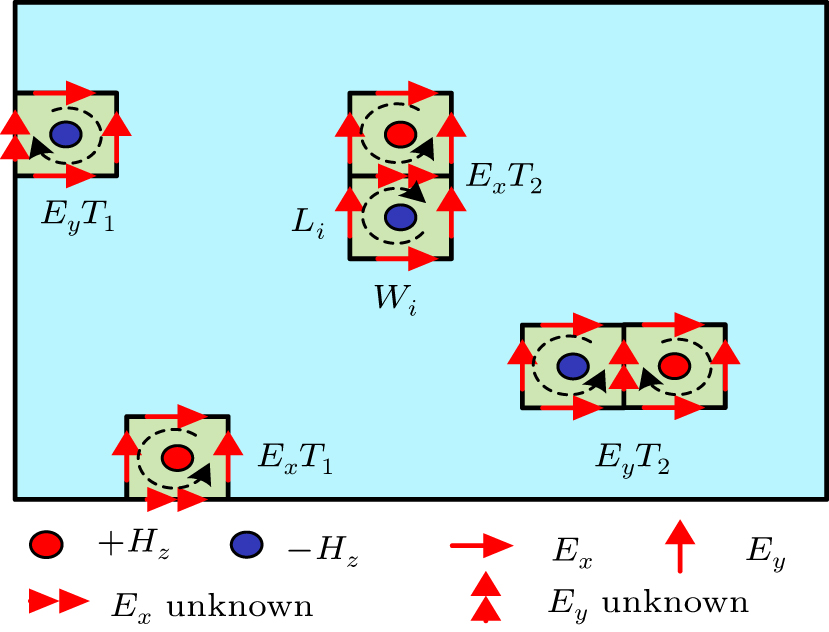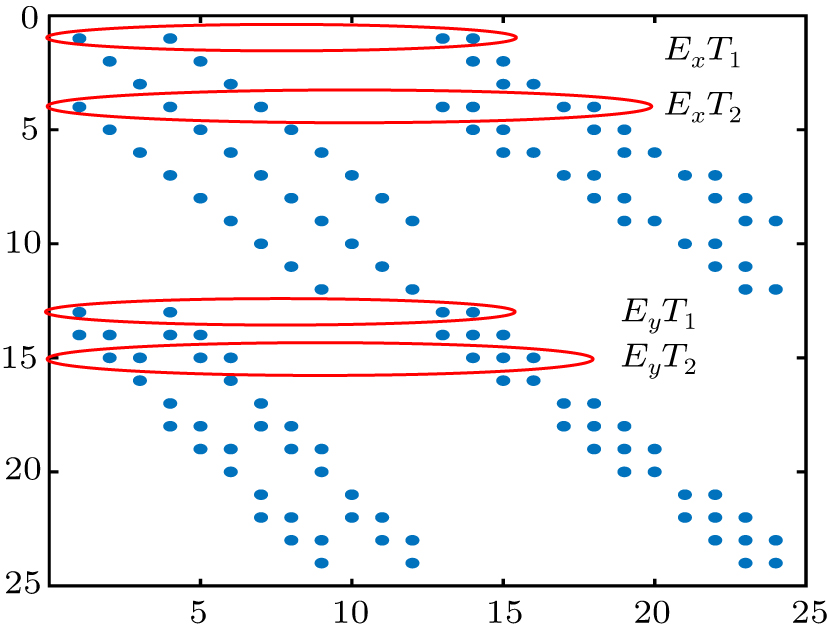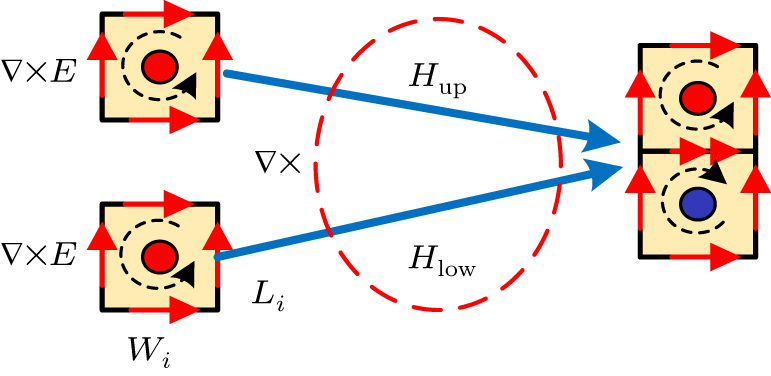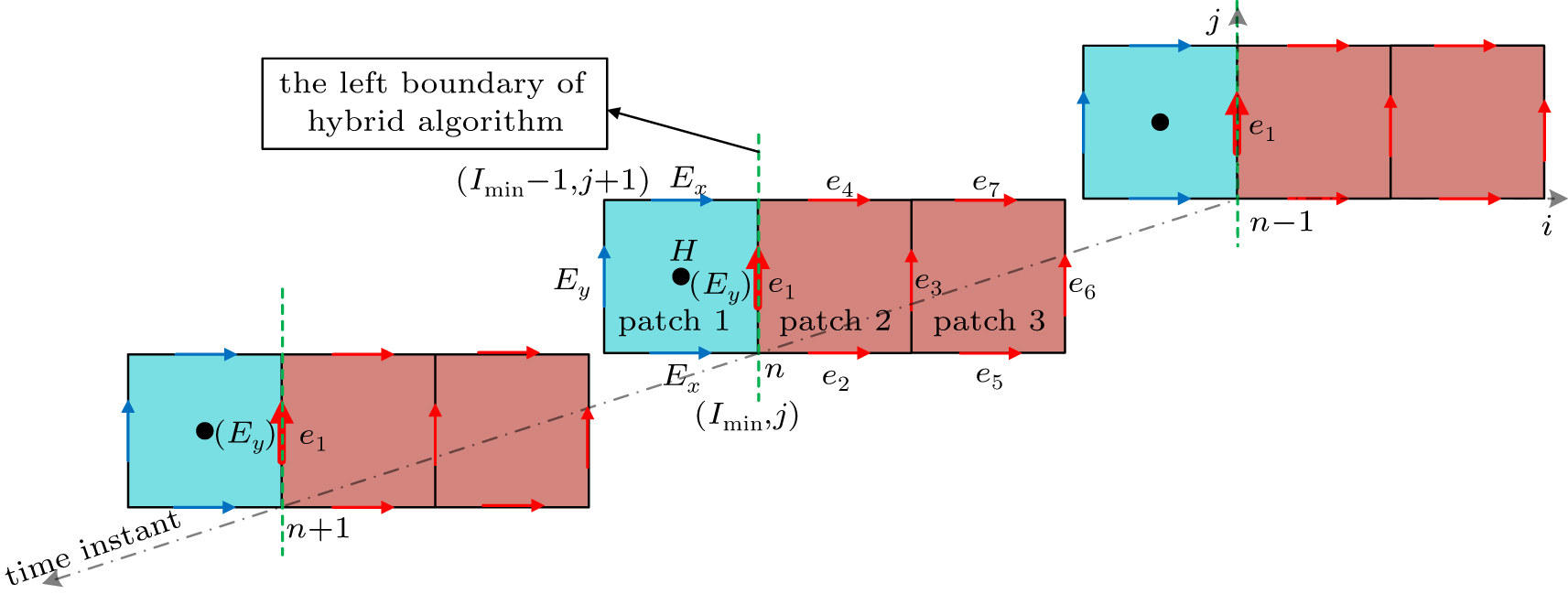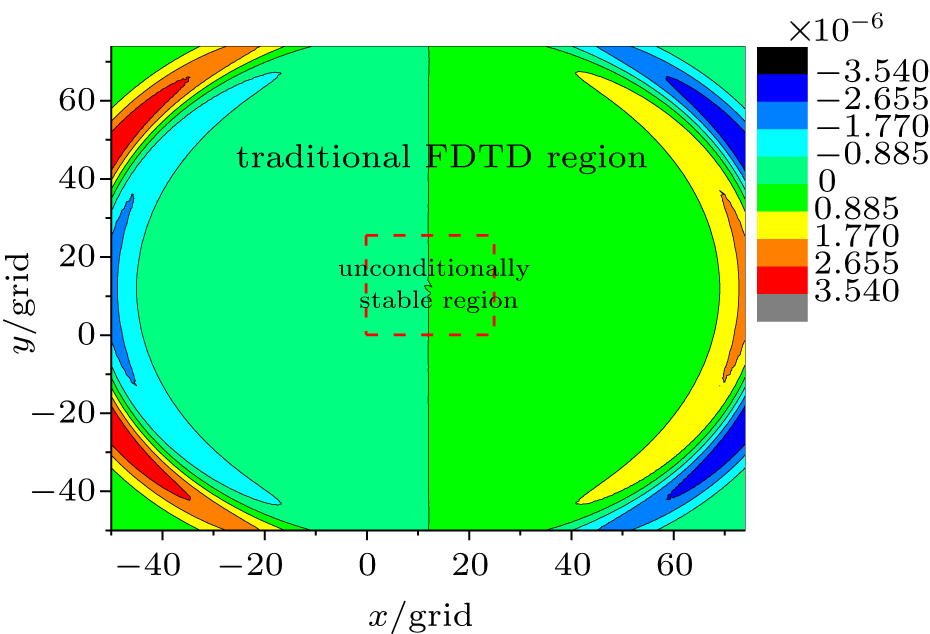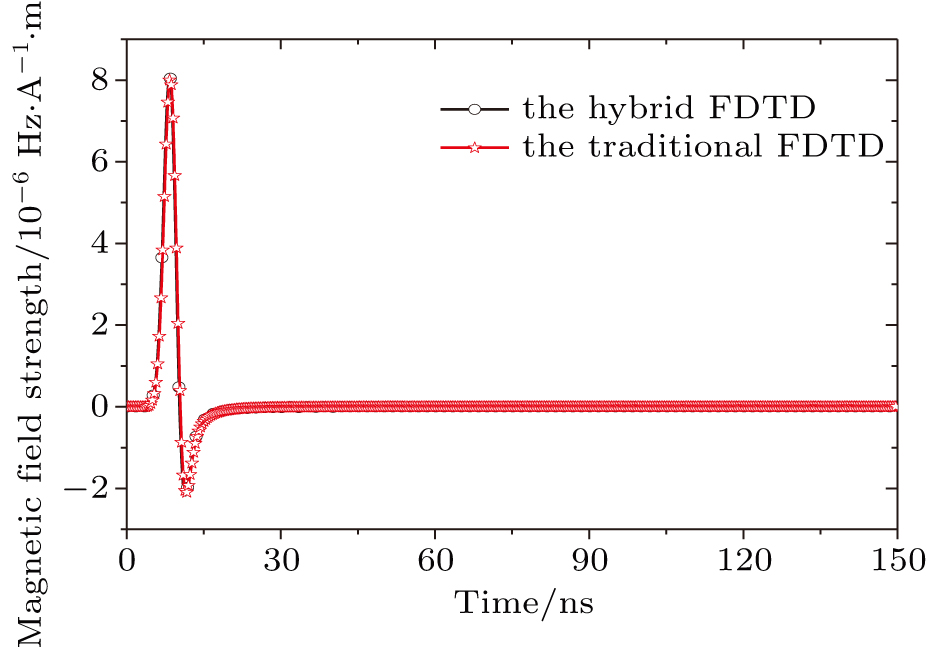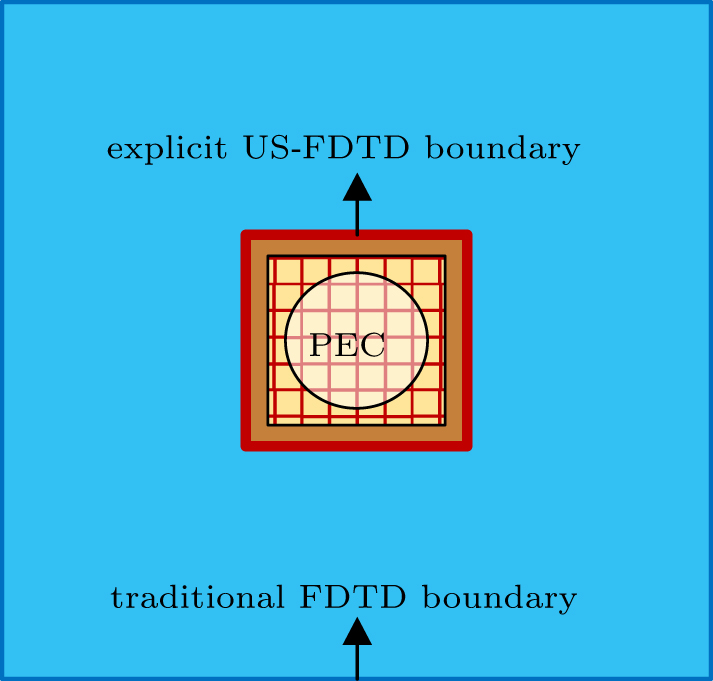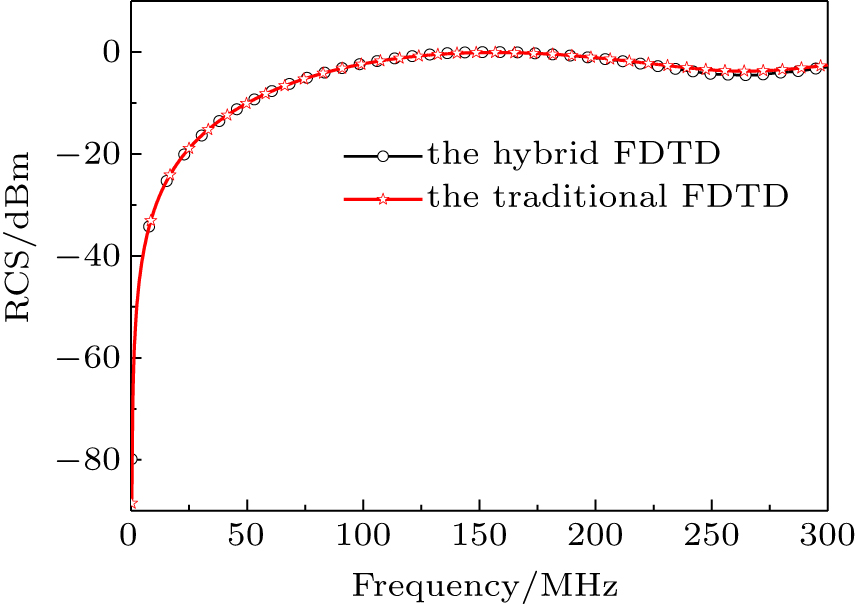† Corresponding author. E-mail:
Project supported by the National Natural Science Foundation of China (Grant No. 61571348) and the Equipment Pre-Research Foundation of China (Grant No. 61405180202).
Since the time step of the traditional finite-difference time-domain (FDTD) method is limited by the small grid size, it is inefficient when dealing with the electromagnetic problems of multi-scale structures. Therefore, the explicit and unconditionally stable FDTD (US-FDTD) approach has been developed to break through the limitation of Courant–Friedrich–Levy (CFL) condition. However, the eigenvalues and eigenvectors of the system matrix must be calculated before the time iteration in the explicit US-FDTD. Moreover, the eigenvalue decomposition is also time consuming, especially for complex electromagnetic problems in practical application. In addition, compared with the traditional FDTD method, the explicit US-FDTD method is more difficult to introduce the absorbing boundary and plane wave. To solve the drawbacks of the traditional FDTD and the explicit US-FDTD, a new hybrid FDTD algorithm is proposed in this paper. This combines the explicit US-FDTD with the traditional FDTD, which not only overcomes the limitation of CFL condition but also reduces the system matrix dimension, and introduces the plane wave and the perfectly matched layer (PML) absorption boundary conveniently. With the hybrid algorithm, the calculation of the eigenvalues is only required in the fine mesh region and adjacent coarse mesh region. Therefore, the calculation efficiency is greatly enhanced. Furthermore, the plane wave and the absorption boundary introduction of the traditional FDTD method can be directly utilized. Numerical results demonstrate the effectiveness, accuracy, stability, and convenience of this hybrid algorithm.
The finite-difference time-domain (FDTD) method is a very popular time-domain algorithm in electromagnetics.[1,2] Nevertheless, due to the limitation of the Courant–Friedrich–Levy (CFL) condition, it is inefficient to deal with the electromagnetic problems of objects with multi-scale structures or fine structures. To break through the limitation of CFL condition, unconditionally stable FDTD (US-FDTD) methods have been proposed. At present, unconditionally stable techniques subject to significant usage or research interest fall into three categories, including alternating-Direction Implicit (ADI) and Locally One-Dimensional (LOD) schemes, orthogonal expansions in time and removal of unstable eigenmodes of the spatial discretization.[3] Among them, ADI[4–6] and LOD,[7,8] orthogonal expansions are implicit methods.[9–12] Namely, the inverse of the matrix is necessary to be solved in the process of iteration. Although these implicit methods are unconditionally stable, they also have some disadvantages. The numerical dispersion errors of ADI-FDTD and LOD-FDTD increase markedly when the time step exceeds the CFL condition. The orthogonal expansions in time methods have a considerably more complicated formulation than the traditional FDTD, if the calculation scale is large relative to the wavelength, the computation efficiency of these methods is not practical. Removal of unstable eigenmodes of the spatial discretization is an explicit method that does not sacrifice the calculation accuracy.[13,14] This explicit method avoids matrix inversion, but it requires eigenvalue decomposition of matrix before time iteration to filter out unstable modes. Calculating the eigenvalues of a large matrix is also time consuming. In addition, the excitation of plane wave and disposal of PML absorbing boundary are complicated.
In view of these problems, a hybrid FDTD algorithm is proposed in this paper. The computational domain is divided into three regions, denoted by I, II, and III; as shown in Fig.
For convenience, take the lossless problem as an example. The curl equations of Maxwell can be discretized into the following forms:[15,16]









By substituting Eq. (





The explicit marching can then be carried out using the update system matrix as







The hybrid FDTD algorithm is developed in this paper by combining the explicit US-FDTD with the traditional FDTD method. According to Ref. [17], the instability is caused by the fine mesh and the adjacent coarse mesh. Consequently, the hybrid method is possible to be adopted, in which the time step can be determined according to the grid size of the region III, and then filters out the unstable modes in the regions I and II.
For the two-dimensional TE wave (Hz, Ex, Ey), the component of the electric field along the x direction Ex can be divided into two categories; i.e., the boundary electric field 










The key of the hybrid algorithm is the processing of the boundary, and the boundary is only related to the space. The explicit US-FDTD uses a second-order iteration equation of electric field. In the time domain, the electric field at time instant n+1 is related to the electric field at time instant n and 











For the propagation and scattering problems, it is necessary to introduce the plane wave and the excellent absorbing boundary into the calculation area. For this purpose, this paper presents a simple method to add the plane wave and the perfectly matched layer (PML) absorbing boundary in the calculation area. Regarding this method, the boundaries in the explicit US-FDTD and the traditional FDTD are combined. Figure
The size of the calculation area is 12.5 m × 12.5 m and the coarse grid size is Lc = 0.1 m. The entire calculation area is discretized into 125 × 125 coarse grids, and the calculation in the area composed by the central 25 × 25 grids is done with the explicit US-FDTD, and the calculation in the rest area is conducted by the traditional FDTD. A coarse mesh at the center of the explicit US-FDTD calculation region is refined with a size ratio of n = 15. A Gaussian current source along the y direction is located at the center of the fine mesh in the form 


| Table 1.
Results of the dimension of the system matrix and time of different methods. . |
The second example is the scattering problem of an infinite PEC cylinder. The maximum frequency of incident wave is 300 MHz, and the radius of the cylinder is 0.25 m. The size of the calculation area including absorbing boundary is 2 m × 2 m. The cylinder is located at the center of the calculation region. The coarse grid size Lc is 0.05 m, and the region of the cylinder is subdivided into fine cells with the contrast ratio being n = 3. Therefore, the fine grid size Lf is 0.0167 m. The computational model of hybrid method is shown in Fig. 

A new hybrid FDTD method is proposed in this paper. The time step of this hybrid method is only determined by the coarse mesh, thus this method can achieve unconditional stability. This hybrid method can also reduce the matrix size of eigenvalue decomposition and can greatly improve the computational efficiency. Moreover, the hybrid approach successfully introduces the plane wave and PML absorbing boundary into the calculation area, which increases the convenience of simulation. All of the numerical comparisons show the good availability of the proposed hybrid method and the advantages of the proposed method lays the foundation to the analyses of complex multi-scale structures in the future.
| [1] | |
| [2] | |
| [3] | |
| [4] | |
| [5] | |
| [6] | |
| [7] | |
| [8] | |
| [9] | |
| [10] | |
| [11] | |
| [12] | |
| [13] | |
| [14] | |
| [15] | |
| [16] | |
| [17] |



